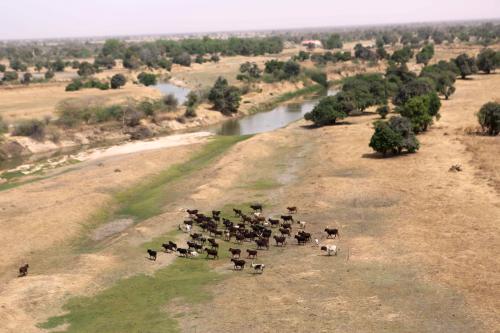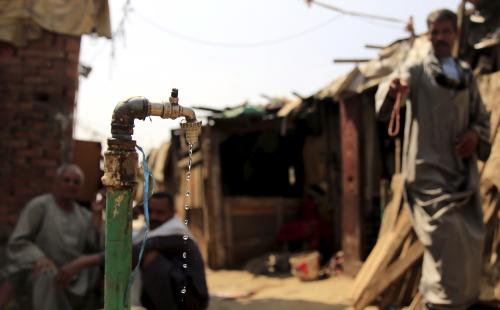The Sahel region in West Africa is one of the poorest parts of the world. Around 40 percent of the populations of Burkina Faso, Chad, Mali, Niger, and Senegal live on less than $1.90 a day. The Sahel also has one of the youngest and fastest-growing populations globally, with population sizes expected to double by 2045. However, the expanding future generation of the Sahel faces dire prospects as their countries are among those with the lowest levels of human capital in the world. Take Chad: According to the World Bank’s Human Capital Index, a child born in Chad today will be less than a third as productive as she could be with complete education and health and no poverty. The equivalent number for sub-Saharan Africa is 40 percent on average and 88 percent for Singapore, the global human capital leader.
What’s worse, the countries of the Sahel are particularly vulnerable to climate change, undermining their long-term development prospects and the chances of the next generation. Temperatures in the Sahel are expected to rise 1.5 times faster than the global average, which, with current projections, means that by 2030 temperatures could be well over 4 degrees Celsius higher than pre-industrial levels if no dramatic shift happens. Since the 1970s, droughts in the Sahel have become more frequent and are affecting more and more people (see Figure 1). Meanwhile, rainy seasons are becoming shorter, more intense, and less predictable, raising the risk of floods in what is otherwise one of the driest places in the world. In a region where more than 80 percent of the poor live in rural areas and live off the land, the threat of climate change to livelihoods looms large. In turn, climate change in the Sahel goes hand in hand with worsening fragility and conflict, fueled by a growing external terrorist threat, and increased displacement: More and more young Sahelians are on the move in the region or looking for a better life in Europe.

Why is climate change such a threat to development prospects in the Sahel? Rising temperatures, drought, and floods undermine food security by disrupting agricultural production, reducing crop yields, and depleting assets such as livestock and savings of poor households. Food insecurity, in turn, can hold back human capital formation if families take their children out of school. Poor feeding as a result of droughts during the first 1,000 days of a child’s life leads to child malnutrition which can have long-lasting effects on a child’s productive prospects. In the Sahel region, stunting rates range between 17 percent of children under age five in Senegal and more than 40 percent in Niger.
Once a drought and food crisis hit a country, the global community typically responds with emergency humanitarian aid. However, an increasing number of Sahelian governments are now also implementing social protection programs to help poor households adapt to climate change. These “adaptive” social protection programs are designed to build the resilience of the poor before, during, and after the occurrence of climate shocks.
Adaptive social protection programs stand on two legs. First, monthly or quarterly cash transfers can help poor households meet basic needs and diversify their subsistence agriculture livelihoods and, as a result, make them less vulnerable to climate shocks. This is especially so when cash transfers are coupled with other interventions like savings promotion or training for beneficiaries: Adaptive cash transfer programs with associated savings groups in Niger have been found to lead to investments in assets, such as livestock, that are sustained 18 months after the end of the program and support a diversification of livelihoods among the extreme poor. Second, social safety nets can be made “shock responsive,” providing emergency cash transfers to poor households in climate-vulnerable regions of the Sahel when droughts or flooding occur. Adaptive cash can help households ensure sustained infant feeding or avoid selling assets which would undermine their long-term livelihoods.
How to build climate-adaptive social protection programs in the Sahel? To start, countries need to lay the necessary foundations for social safety nets like population identification systems, social registries of beneficiaries, and reliable payment mechanisms. Coverage of social safety net programs and their foundations remain low in most Sahelian countries. For example, only one-third of the extreme poor in Mauritania—and even fewer elsewhere—are receiving cash transfers. But coverage is expanding across the Sahel, with the potential to “leapfrog” through new technologies like biometric IDs and mobile and digital payment systems.
Moreover, countries should explore ways to strengthen early warning systems that draw on satellite weather data and help predict droughts and floods, coupled with automatic triggers to initiate cash transfer payments before the worst effects of a disaster are felt by the affected people. And there are also opportunities on the horizon to link these programs to a range of disaster risk financing instruments, mobilizing prepositioned funding to ensure that the resources are available to respond quickly to large climate shocks through adaptive social protection.
Adaptive social protection programs in the Sahel are still in their infancy and institutions need to be strengthened. But the growing threats posed by climate change to poverty reduction in the Sahel call for new solutions and ambition. Adaptive social protection holds promise, and governments in the Sahel should seize this promise to prevent climate change from holding back the next generation.






Commentary
Climate change in the Sahel: How can cash transfers help protect the poor?
December 4, 2019